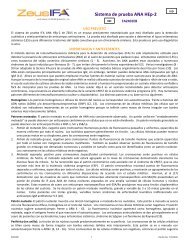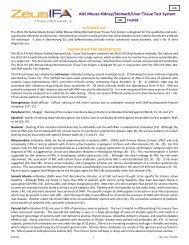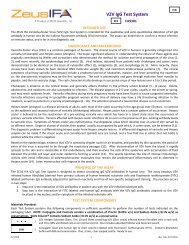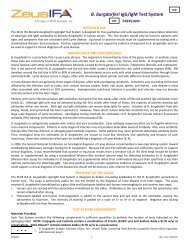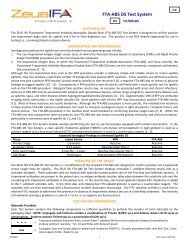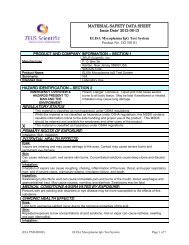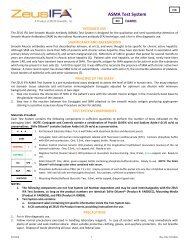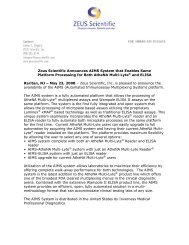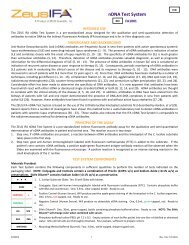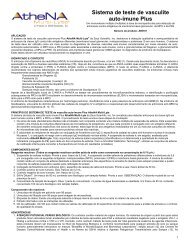English - ZEUS Scientific
English - ZEUS Scientific
English - ZEUS Scientific
You also want an ePaper? Increase the reach of your titles
YUMPU automatically turns print PDFs into web optimized ePapers that Google loves.
ANA/HEp-2 IFA Test System<br />
For In Vitro Diagnostic Use<br />
Intended Use<br />
The Zeus <strong>Scientific</strong>, Inc. ANA/HEp-2 Test System is a prestandardized kit designed for the qualitative and semiquantitative<br />
detection of antinuclear antibodies. The test is intended to aid in determining SLE and differentiating<br />
clinically similar connective tissue disorders, and is for in vitro diagnostic use.<br />
Significance and Background<br />
The indirect fluorescent antibody (IFA) technique method has been used extensively for detecting the presence of<br />
ANA in the sera of patients with systemic lupus erythematosus (SLE), and other clinically similar connective tissue<br />
disorders (1-5). In addition, ANA may be associated with numerous drug-induced lupus syndromes (6-7) which<br />
clinically mimic the spontaneous form of SLE. The IFA technique was adapted to ANA testing by several<br />
investigators (8-9) following the basic methods originally described by Coons (10). ANA are primarily composed of<br />
IgG antibodies; however, IgA and IgM ANA may also be detected (11). It is now recognized that many sources of<br />
nuclear material may be employed as a substrate for ANA testing. Although most of the original ANA research was<br />
performed using rat or mouse liver or kidney tissue section substrate, the use of human or animal embryonic<br />
tissue cell culture substrates has provided a reliable and easy to interpret alternative substrate for ANA testing.<br />
The HEp-2 cell line is a recommended substrate for detecting centromere antibody, which is highly indicative of<br />
the CREST variant of progressive systemic sclerosis (27). There are several different patterns of nuclear and<br />
cytoplasmic immunofluorescence. These various patterns and the basis for them are as follows:<br />
Homogeneous - Homogeneous or diffuse staining patterns of the nucleus is consistent with autoantibodies to<br />
native DNA (nDNA) histones and/or deoxyribonucleoprotein (DNP) (12,13). The chromosomes of the mitotic cells<br />
(dividing cells) are important indicators of a homogeneous pattern because they will stain as irregularly shaped<br />
masses with more intensely stained outer edges.<br />
Speckled Patterns - The speckled pattern is the most commonly observed ANA pattern. A uniform “true speckled”<br />
pattern may be seen with centromere antibodies in cells not in division. A clumpy speckled pattern may be seen<br />
with antibodies to n-RNP, Sm, and SSB/La.<br />
1. Fine speckled pattern, chromosome-negative:<br />
Numerous small and uniform points of fluorescence uniformly scattered throughout the nucleus. The nucleoli<br />
will generally appear unstained. The mitotic cells may demonstrate a few speckles in their cytoplasm, but the<br />
chromosomes will be negative.<br />
2. Course speckled pattern, chromosome-negative:<br />
Medium-sized points of fluorescence will be scattered throughout the nuclei with distinct nuclear margins.<br />
Larger-sized points of fluorescence may also be observed; however, they are too numerous and variable in size<br />
to be identified as a nucleolar pattern. The chromosomes in the mitotic cells will be negative<br />
3. Discrete speckled, chromosome (centromere specificity) positive:<br />
The chromosomes will be positive in mitotic cells; in fact, the discrete speckles will only be clustered in the<br />
chromosome mass clearly demonstrating the various stages of mitosis. The centromere pattern has been<br />
1
ecognized to be associated with the CREST syndrome, which is a milder variant of progressive systemic sclerosis<br />
(PSS).<br />
The centromere pattern will demonstrate discrete and uniform points of fluorescent speckles scattered<br />
throughout the nucleus. Mitotic cells will be positive, demonstrating a clustering of the centromeres in the<br />
chromosomes in different arrangements according to the mitotic stage.<br />
Harmon and co-workers (17) demonstrated that serum samples containing highly monospecific anti-SSA/Ro<br />
gave an IF-ANA test pattern of discrete nuclear speckles on a wide variety of human cells and tumor nuclei. Such<br />
serum samples with monospecific anti-SSA/Ro produced very little cytoplasmic staining of substrate cells.<br />
A distinct, large, variable speckled pattern of 3 to 10 large speckles in the nucleus has been described. These<br />
patients with large, variable speckles have undifferentiated rheumatic disease syndromes with IgM antihistone<br />
H-3 antibody (18).<br />
Nucleolar Pattern - The nucleolar pattern demonstrates a homogeneous or speckled staining of the nucleolus. This<br />
pattern is often associated with a dull, homogeneous fluorescence in the rest of the nucleus. The chromosomes in<br />
the mitotic cells will be negative. The nucleolar pattern suggests autoantibodies to 4-6S RNA. The nucleolar<br />
fluorescence will appear as homogeneous, clumped, or speckled, depending on the antigen to which the<br />
autoantibody reacts.<br />
Antinucleolar antibodies occur primarily in the sera of patients with scleroderma, systemic lupus erythematosus,<br />
Sjögren’s syndrome, or Raynaud’s phenomenon (19).<br />
Peripheral (Rim) - The nuclei stain predominantly at their periphery. The chromosomes of the mitotic cells stain as<br />
irregularly shaped masses with more intensely stained outer edges. This pattern is often seen with autoantibodies<br />
to nDNA (3,14-16). If the chromosomes of the mitotic cells are negative, then the pattern would be suggestive of<br />
autoantibodies to the nuclear membrane and not to nDNA, and not reported as a peripheral pattern. (See nuclear<br />
membrane interpretation below).<br />
Additional Patterns<br />
1. Spindle fiber pattern, chromosome-positive:<br />
The spindle fiber pattern is unique to cells undergoing mitosis where only the spindle apparatus fluoresces. This<br />
pattern has a “spider web” appearance extending from the centriole to the centromeres. The pattern is<br />
suggestive of autoantibodies to the microtubules and its significance is unclear; however, an association<br />
between the spindle fiber pattern and carpal tunnel syndrome has been suggested.<br />
2. Midbody pattern:<br />
The midbody pattern is a densely staining region near the cleavage furrow of telophase cells, that is, in the area<br />
where the two daughter cells separate. The clinical significance of the pattern is unknown; however, the pattern<br />
has been recognized in selected patients with systemic sclerosis.<br />
3. Centriole pattern:<br />
The centriole pattern is characterized by two distinct points of fluorescence in the nucleus of the mitotic cells or<br />
one distinct point of fluorescence in the resting cell. The significance of this pattern is not known; however, it<br />
has been observed in PSS.<br />
4. Proliferating cell nuclear antigen (PCNA) pattern:<br />
The proliferating cell nuclear antigen pattern is observed as a fine to course nuclear speckling in 30-60% of the<br />
cells in interphase, and a negative staining of the chromosome region of mitotic cells. The PCNA is very specific<br />
for patients with SLE but not detected in other connective tissue disease disorders. It has been reported that SLE<br />
patients with the PCNA pattern have a higher incidence of diffuse glomerulonephritis.<br />
5. Antinuclear membrane (nuclear laminae):<br />
The antinuclear membrane pattern appears as a rim around the nucleus and resembles a rim pattern; however,<br />
it is distinguished from the rim pattern by the fact that the metaphase chromosome stage is negative. This<br />
autoantibody is important to report because it was recently recognized to be associated with autoimmune liver<br />
disease.<br />
Cytoplasmic Patterns<br />
1. Mitochondrial (AMA) pattern:<br />
The pattern will characteristically have numerous cytoplasmic speckles with the highest concentration in the<br />
peri-nuclear area. The pattern can be observed in interphase and mitotic cells. The clinical significance of AMA is<br />
most frequently an association with primary biliary cirrhosis, especially when the AMA is a high titer.<br />
2
2. Golgi apparatus pattern:<br />
The golgi apparatus pattern is characterized by positive cytoplasmic staining that is concentrated on only one<br />
side of the perinuclear region. The clinical significance is uncertain, but reports in the literature have suggested<br />
an association with SLE and Sjögren’s Syndrome.<br />
3. Lysosomal pattern:<br />
The lysosomal pattern is observed as a few discrete speckles sparsely spaced throughout the cytoplasm. The<br />
pattern is observed in the cytoplasm of interphase and mitotic cells. The clinical significance is unknown.<br />
4. Ribosomal pattern:<br />
The ribosomal pattern is characterized by numerous cytoplasmic speckles with the highest concentration<br />
around the nucleus. It is distinguished from the mitochondrial pattern because of the smaller specks and higher<br />
density. The significance of the pattern is unknown.<br />
1. Cytoskeletal pattern:<br />
The cytoskeletal pattern is characterized by a distinct “spider web” or fibrous appearance throughout the cell. It<br />
has been reported to be associated with autoimmune liver disease (anti-smoothmuscle).<br />
ANA Negative<br />
Autoantibody to SSA/Ro is present in high frequency in a clinical subset of lupus called subacute cutaneous lupus<br />
erythematosus (SCLE). Many patients with SCLE have been falsely labeled as having “ANA-negative” lupus. We now<br />
know that many of these so-called “ANA-negative” LE patients will demonstrate a positive IF-ANA on substrate of<br />
HEp-2 cells containing the SSA/Ro antigen (20).<br />
Anti-SSA/Ro antibodies may be present in the absence of traditional ANAs, with SLE seen in persons genetically<br />
deficient in C4 and occasionally other complementary deficiencies (21,22). This combination may be more<br />
common in black persons (23,24). In addition, C4 deficiency may be associated with increased susceptibility to<br />
development of SLE upon treatment with hydralazine (25). These patients, if female, are likely to deliver infants<br />
with congenital heart block or lupus dermatitis (26).<br />
Although the level of ANA may not correlate with the clinical course of a particular autoimmune disease state (6),<br />
the various patterns of nuclear staining may be associated with specific disease states (3,16,28-31).<br />
The following table summarizes the various autoantibodies noted above with respect to disease association:<br />
Table 1<br />
Antibody Disease State Relative Frequency of Antibody Detection %<br />
Anti-Jo-1 Myositis 25-44% (18)<br />
Anti-Sm SLE 30 *<br />
Anti-RNP MCTD, SLE 100** and > 40, respectively<br />
Anti-SSA/Ro SLE, Sjögren’s 15 and 30-40, respectively<br />
Anti-SSBLa SLE, Sjögren’s 15 and 60-70, respectively<br />
Anti-Scl-70 Systemic sclerosis 20-28 *<br />
* Highly Specific<br />
** Highly Specific when present alone at high titer<br />
Principle of the Assay<br />
The Zeus <strong>Scientific</strong>, Inc. ANA/HEp-2 Test System is designed to detect the presence of circulating ANA in human<br />
sera. The system employs tissue cell culture substrate and goat anti-human immunoglobulin adjusted for optimum<br />
use and free of nonspecific background staining. The reaction occurs in two steps:<br />
1. During the first (sample) incubation, any ANA present in the patient sample may bind to the cell substrate,<br />
forming an antigen-antibody complex. Other serum components are subsequently washed away.<br />
2. During the second (conjugate) incubation, anti-human immunoglobulin labeled with FITC is allowed to react<br />
with any human immunoglobulin that bound to the substrate during the sample incubation. This will form a<br />
stable antigen-antibody-conjugate complex at the location where the initial patient antibody bound to the cell<br />
substrate. Excess conjugate is subsequently washed away.<br />
3. The results of the assay can be visualized using a properly equipped fluorescent microscope. Any positive<br />
reactions will appear as apple-green fluorescent staining within the cell. If the sample had no specific ANA,<br />
there will be no distinct nuclear staining of the cell.<br />
3
Kit Components<br />
Reactive Reagents:<br />
1) Substrate Slides: ANA HEp-2 cell culture substrate slides containing a layer of HEp-2 cells that were<br />
grown on the slide and subsequently stabilized. Slides are packaged in a poly-foil pouch with desiccant<br />
and blotter. Well configurations will vary depending on kit product number.<br />
2) Conjugate: Dripper-tipped bottle containing goat anti-human immunoglobulin labeled with fluorescein<br />
isothiocyanate (FITC) and counterstain. Ready to use, 7 mL.<br />
3) Negative Control: Dripper-tipped bottle containing human ANA-negative control serum. Ready to use,<br />
1.0mL.<br />
4) Positive Controls:<br />
a) Homogeneous Control: Dripper-tipped bottle containing human ANA-positive control serum<br />
producing 4+ homogeneous nuclear staining with the substrate cells. Ready to use, 1.0mL.<br />
b) Speckled Control: Dripper-tipped bottle containing human ANA-positive control serum producing 4+<br />
speckled nuclear staining with the substrate cells. Ready to use, 1.0mL.<br />
c) Nucleolar Control: Dripper-tipped bottle containing human ANA-positive control serum producing<br />
4+ nucleolar staining with the substrate cells. Ready to use, 1.0mL.<br />
d) Centromere Control: Dripper-tipped bottle containing human ANA-positive control serum producing<br />
4+ centromere staining with the substrate cells. Ready to use, 1.0mL<br />
5) Minimally Reactive Control: Dripper-tipped bottle containing human ANA-positive control serum<br />
producing a 1+ homogeneous nuclear staining with the substrate cells. Ready to use, 1.0mL.<br />
Non-reactive Reagents:<br />
1. Phosphate-buffered-saline (PBS), pH 7.2 ± 0.2. (Product #:0008).<br />
2. Phosphate buffered glycerol (mounting media), 3mL. (Product #:0009).<br />
3. Blotters.<br />
Precautions<br />
1. For in vitro diagnostic use.<br />
2. Reagents may contain a preservative that may be toxic if ingested.<br />
3. Non-nuclear staining of the cell substrate may be observed with some human sera.<br />
4. Do not apply pressure to slide envelope. This may damage the substrate.<br />
5. Reagents from other sources or manufacturers should not be used. Follow test procedure carefully.<br />
6. Reconstitute reagents gently but thoroughly. Reagents should be free of particulate matter. If reagents<br />
become cloudy, bacterial contamination should be suspected.<br />
7. DO NOT freeze and thaw reagents more than once. Repeated freezing and thawing destroys antibody<br />
activity.<br />
8. The human serum controls are POTENTIALLY BIOHAZARDOUS MATERIALS. Source materials from which<br />
these products were derived were found negative for HIV-1 antigen, HBsAg. and for antibodies against HCV<br />
and HIV by approved test methods. However, since no test method can offer complete assurance that<br />
infectious agents are absent, these products should be handled at the Biosafety Level 2 as recommended for<br />
any potentially infectious human serum or blood specimen in the Centers for Disease Control/National<br />
Institutes of Health manual “Biosafety in Microbiological and Biomedical Laboratories”: current edition; and<br />
OSHA’s Standard for Bloodborne Pathogens (39).<br />
9. Never pipette by mouth. Avoid contact of reagents and patient specimens with skin and mucous<br />
membranes.<br />
Materials Required But Not Provided<br />
1. Pipets capable of delivering 10 to 200 uL.<br />
2. Small serological, Pasteur, capillary or automatic pipettes.<br />
4
3. Small test tubes, 13 x 100mm or a 96 well sample dilution plate for preparing sample dilutions<br />
4. Disposable reagent reservoirs<br />
5. Staining dish: A large staining dish with a small magnetic mixing set-up provides an ideal mechanism for<br />
washing slides between incubation steps.<br />
6. Cover slips, thickness No. 1.<br />
7. Moist chamber.<br />
8. Distilled or deionized water.<br />
9. Properly equipped fluorescence microscope assembly with the proper stage for the slide configuration used.<br />
The following filter systems or their equivalent have been found to be satisfactory for routine use with transmitted<br />
or incident light dark-field assemblies:<br />
TRANSMITTED LIGHT<br />
Light Source: Mercury vapor 200W or 50W<br />
Excitation Filter Barrier Filter Red Suppression<br />
Filter<br />
KP490 K510 or K530 BG38<br />
BG12 K510 or K530 BG38<br />
FITC K520 BG38<br />
Light Source: Tungsten – Halogen 100W<br />
KP490 K510 or K530 BG38<br />
INCIDENT LIGHT<br />
Light Source: Mercury Vapor 200, 100, 50 W<br />
Excitation<br />
Filter<br />
Dichroic<br />
Mirror<br />
Barrier Filter Red Suppression<br />
Filter<br />
KP500 TK510 K510 or<br />
BG38<br />
K530<br />
FITC TK510 K530 BG38<br />
Light Source: Tungsten – Halogen 50 and 100 W<br />
KP500 TK510 K510 or<br />
BG38<br />
K530<br />
FITC TK510 K530 BG38<br />
Specimen Collection<br />
Only freshly drawn and properly stored blood sera obtained by approved aseptic venipuncture procedures should<br />
be used in this assay (32,33). No anticoagulants or preservatives should be added. Avoid using hemolyzed,<br />
lipemic, or bacterially contaminated sera.<br />
Store sample at room temperature for no longer than 8 hours. If testing is not performed within 8 hours, sera may<br />
be stored at 2-10° C for no longer than 48 hours. If delay in testing is anticipated, store test sera at -20°C or lower.<br />
Avoid multiple freeze/thaw cycles which may cause loss of antibody activity and give erroneous results.<br />
Storage Conditions<br />
1. Tissue cell culture substrate slides: Store at 2 to 8°C.<br />
2. Goat anti-human immunoglobulin labeled with FITC: Store at 2 to 8°C.<br />
3. Human ANA positive and negative control sera: Store at 2 to 8°C.<br />
4. Phosphate-buffered-saline (PBS): Store packets at 2-25°C. Rehydrated PBS is stable for 30 days when stored at<br />
2 to 8°C.<br />
5. Phosphate buffered glycerol (mounting media): Store at at 2 to 8°C.<br />
NOTE:<br />
5
1. All kit components are stable until the expiration date printed on the label provided the recommended<br />
storage conditions are strictly followed. DO NOT use beyond expiration date.<br />
2. Do not freeze and thaw reagents or patient samples more than once. Repeated freezing and thawing destroys<br />
antibody activity. Do not store in self-defrosting freezers.<br />
Assay Procedure<br />
Preparation of Reagents:<br />
1. Phosphate-buffered-saline (PBS). Empty contents of one buffer packet into one liter of distilled or deionized<br />
water. Mix until all salts are thoroughly dissolved.<br />
2. Human ANA positive controls. Use as packaged. Do not dilute.<br />
3. Human ANA minimally reactive positive control. Use as packaged. Do not dilute<br />
4. Human ANA negative control. Use as packaged. Do not dilute.<br />
5. Goat anti-human immunoglobulin FITC labeled conjugate. Use as packaged. Do not dilute.<br />
Note: The controls are intended to be used undiluted. As an option, users may titrate the positive control(s) to<br />
endpoint. In such cases, the control(s) should be diluted two-fold in PBS. When evaluated by Zeus <strong>Scientific</strong>, Inc.,<br />
an endpoint dilution is established and printed on the homogeneous positive control vial (± one dilution). It should<br />
be noted that due to variations within the laboratory (equipment, etc.), each laboratory should establish its own<br />
mean titer for each lot of control.<br />
Test Procedure:<br />
1. Remove slides from storage and allow them to warm to room temperature (20-25°C). Tear open the<br />
protective envelope and remove slides containing the HEp-2 cell culture substrate. DO NOT APPLY PRESSURE<br />
TO FLAT SIDES OF PROTECTIVE ENVELOPE.<br />
2. Prepare patient sera at 1:40 dilution in PBS (for example: 10µL of sample plus 390µL of PBS). If additional serial<br />
dilutions are to be tested, prepare subsequent dilutions in reconstituted PBS. After adding patient sample to<br />
PBS, mix the sample well by withdrawing and expelling the specimen several times.<br />
3. Identify each well with the appropriate patient sera and controls.<br />
4. If test samples are to be titered, serial dilutions should be made in reconstituted PBS.<br />
5. Using suitable dispenser (capillary, Pasteur, or automatic pipette), dispense one drop or approximately 20 uL<br />
of patient sera and control sera on the cells in the respective wells. Spread sera over entire area of the wells<br />
being careful not to touch substrate with pipette tip.<br />
6. Incubate slides in a moist chamber at room temperature (20-25°C) for 20 to 30 minutes.<br />
7. Remove slides from the moist chamber one at a time and gently rinse with a stream of PBS. DO NOT DIRECT<br />
THE STREAM OF PBS INTO THE TEST WELLS. NOTE: To avoid cross-contamination when using the 96-well test<br />
system, place slide in palm of hand and grasp edges with fingertips. Quickly invert the slide and, using a “snap”<br />
motion, expel excess sera.<br />
8. Place slides in a staining dish and wash in PBS for two, 5 minute intervals with one change of PBS. Use a<br />
magnetic mixing setup or other means of gentle agitation.<br />
9. Remove slides from PBS one at a time. Invert slide and key wells to holes in blotters provided. Blot slide by<br />
wiping the bottom side with an absorbent wipe. CAUTION: Position the blotter and slide on a hard, flat<br />
surface. Do not invert the slide on top of paper towels. Blotting on paper towels may destroy the substrate.<br />
DO NOT ALLOW THE SLIDES TO DRY DURING THE TEST PROCEDURE.<br />
10. Add one drop or approximately 20 uL of conjugate to each well.<br />
11. Repeat steps 6 through 9.<br />
12. Apply a suitable number of drops of mounting media (according to the number of wells per slide) to each slide<br />
(between the wells) and coverslip. NOTE: Be sure each well has mounting media coverage.<br />
13. Examine slides immediately with an appropriate fluorescence microscope assembly. NOTE: If delay in<br />
examining slides is anticipated, seal coverslip with nail polish and store in refrigerator. It is recommended that<br />
slides be examined on the same day of testing.<br />
6
Quality Control<br />
1. Every time the assay is run, a positive control (4+ homogeneous), a minimally positive control (1+<br />
homogeneous), a negative control, and a buffer control must be included.<br />
2. It is recommended that the controls be read prior to evaluating the test samples. If the controls do not appear<br />
as described, results may be invalid.<br />
a. Negative Control - Characterized by the absence of specific fluorescence and a red background<br />
staining of all cells due to counterstain.<br />
b. The homogeneous positive control is characterized by apple-green fluorescence. The homogeneous<br />
staining pattern is a diffused uniform staining of the entire nucleus.<br />
3. Additional controls may be tested according to guidelines or requirements of local, state, and/or federal<br />
regulations or accrediting organizations.<br />
NOTE:<br />
1) Non-specific reagent trapping may exist. It is important to adequately wash slides to eliminate false<br />
positive results.<br />
2) The intensity of the observed fluorescence may vary with the microscope and filter system used.<br />
Additional controls may be tested according to guidelines or requirements of local, state, and/or federal<br />
regulations or accrediting organizations.<br />
Interpretation of Results<br />
1. The interpretation of the results depends on the pattern observed, the titer of the autoantibody, and the age<br />
of the patient. The elderly, especially women, are prone to develop low-titered autoantibodies (
4. One autoantibody pattern may partially or completely obscure the diagnostic features of the other. In such<br />
instances, it is necessary to titrate the serum.<br />
5. No definitive association between the pattern of nuclear fluorescence and any specific disease state is<br />
intended with this product.<br />
Expected Results<br />
The expected value in the normal population is negative. However, apparently healthy individuals may contain<br />
ANA in their sera (38). This percentage increases with aging, particularly in the 7th decade of life.<br />
Performance Characteristics<br />
A. The Zeus <strong>Scientific</strong>, Inc. ANA/HEp-2 test system was tested in parallel with a reference procedure employing rat<br />
liver substrate. Routine ANA testing was performed by both procedures on 434 patient specimens. Of these 434<br />
sera, 116 were positive by both procedures. The Zeus <strong>Scientific</strong>, Inc. ANA/HEp-2 test system showed 97%<br />
agreement with respect to positive and negative results, and 100% with respect to staining pattern. Of the 21<br />
discrepancies in titer, the Zeus ANA/HEp-2 procedure was one dilution lower in 18 specimens. Five of these 18<br />
specimens that were negative using the ANA/HEp-2 procedure were positive at 1:20 by the rat liver reference<br />
procedure.<br />
B. A study was performed using 206 samples obtained from a plasma donor center and a reference laboratory. The<br />
Zeus <strong>Scientific</strong>, Inc. ANA/HEp-2 test system with ZORBA-NS was compared to a commercial ANA/HEp-2 test<br />
system (PBS sample diluent) and the Zeus ANA/HEp-2 test system (PBS sample diluent). With respect to positive<br />
and negative results, there was 96% agreement (198/206) between the Zeus ANA/HEp-2 with ZORBA-NS and<br />
the Zeus ANA/HEp-2 with PBS. In addition, there was 96% agreement (198/206) between the Zeus ANA/HEp-2<br />
with ZORBA-NS and the commercial ANA/HEp-2 test system with PBS.<br />
The discrepant results involved 15 different samples. All 15 were borderline positive when screened using PBS<br />
as the sample diluent and negative when screened using ZORBA-NS. One sample was positive on both tests that<br />
used PBS as the sample diluent. Seven samples were positive using the Zeus ANA/HEp-2 with PBS diluent. The<br />
other seven samples were positive on the commercial ANA/HEp-2 with PBS diluent.<br />
The discrepant samples were retested at 1:40 and titered in the Zeus ANA/HEp-2 (PBS) test system and the<br />
commercial ANA/HEp-2 (PBS) test system. All 15 samples were again borderline reactive at 1:40, but negative at<br />
1:80.<br />
Seventy-nine samples were positive by all three assays with no discrepancies in staining patterns. Twenty-five of<br />
the positive samples were used for an endpoint titer analysis. The endpoint titer results are as follows:<br />
Zeus ANA Hep-2 with ZORBA-NS<br />
Zeus ANA Hep-2 (PBS) Commercial ANA Hep-2<br />
Identical Titer 17 5<br />
± one, two-fold dilution 8 13<br />
± two, two-fold dilutions 0 7<br />
25 25<br />
References<br />
1. Barnett EV:Mayo. Clin. Proc. 44:645, 1969.<br />
2. Burnham TK, Fine G, Neblett TR:Ann. Int. Med. 63:9, 1966.<br />
3. Casals SP, Friou GJ, Meyers LL:Arthritis Rheum. 7:379, 1964.<br />
4. Condemi JJ, Barnett EV, Atwater EC, et al:Arthritis Rheum. 8:1080, 1965.<br />
5. Dorsch CA, Gibbs CB, Stevens MB, Shelman LE:Ann. Rheum. Dis. 28:313, 1969.<br />
6. Dubois EL:J. Rheum. 2:204, 1975.<br />
7. Alarcon-Segovia D, Fishbein E:J. Rheum. 2:167, 1975.<br />
8. Friou GJ:J. Clin. Invest. 36:890, 1957.<br />
9. Friou GJ, Finch SC, Detre KD:J. Immunol. 80:324, 1958.<br />
10. Coons AH, Creech H, Jones RN, et al:J. Immunol. 80:324, 1958.<br />
11. Barnett EV, North AF, Condemi JJ, Jacox RF, Vaughn JH:Ann. Intern. Med. 63:100, 1965.<br />
8
12. Lachman PJ, Kunkel HG:Lancet 2:436, 1961.<br />
13. Friou GJ:Arthritis Rheum. 7:161, 1964.<br />
14. Beck JS:Scot. Med. J. 8:373, 1963.<br />
15. Anderson JR, Gray KG, Beck JS, et al: Ann. Rheum. Dis. 21:360, 1962.<br />
16. Luciano A, Rothfield NF:Ann. Rheum. Dis. 32:337, 1973.<br />
17. Harmon C, Deng JS, Peebles CL, et al: The importance of tissue substrate in the SS-A/Ro antigen-antibody system. Arthritis Rheum. 27:166-<br />
173, 1984.<br />
18. Peebles CL, Molden DP, Klipple GL, Nakamura RM: An antibody to histone H3 which produces a variable large speckled (VLS)<br />
immunofluorescent pattern on mouse kidney. Arthritis Rheum. 27:S44, 1984.<br />
19. Ritchie RF:Antinucleolar antibodies: Their frequency and diagnostic association. N. Engl. J. Med. 282:1174-1178, 1970.<br />
20. Deng JS, Sontheimer RD, Gilliam JN: Relationships between antinuclear and anti-Ro/SS-A antibodies in subacute cutaneous lupus<br />
erythematosus. J. Am. Acad. Dermatol. 11:494-499, 1984.<br />
21. Meyer O, Hauptmann G, Tappeiner G, Ochs HD, Mascart-Lemone F: Genetic deficiency of C4, C2 or C1q and lupus syndromes. Association<br />
with anti-Ro(SSA) antibodies. Clin. Exp. Immunol. 62:678-684, 1985.<br />
22. Provost TT, Arnett FC, Reichlin M:Homozygous C2 deficiency, lupus erythematosus and anti-Ro(SS-A) antibodies. Arthritis Rheum.<br />
26:1279-1282, 1983.<br />
23. Wilson WA, Perez MC, Armatis PE:Partial C4A deficiency is associated with susceptibility to SLE in black Americans. Arthritis Rheum.<br />
31:1171-1175, 1988.<br />
24. Wilson WA, Perez MC:Complete C4B deficiency in black Americans with systemic lupus erythematosus. J. Rheumatol. 15:1855-1858, 1988.<br />
25. Speirs C, Fielder AHL, Chapel H, et al:Complement system protein C4 and susceptibility to hydralazine-induced systemic lupus<br />
erythematosus. Lancet 1:922-924, 1989.<br />
26. Watson RM, Scheel JN, Petri M, et al:Neonatal lupus erythematosus syndrome: Analysis of C4 allotypes and C4 genes in 18 families.<br />
Medicine 71:84-95, 1992.<br />
27. Tan EM, Rodnan GP, Garcia I, Moroi Y, Fritzler MJ, Peebles C:Arthritis Rheum. Vol. 23 No. 6:617, 1980.<br />
28. Hall AP, Bardawil WA, Bayles TB, et al:N. Engl. J. Med. 263:769, 1960.<br />
29. Pollack VE:N. Engl. J. Med. 271:165, 1964.<br />
30. Raskin J:Arch. Derm. 89:569, 1964.<br />
31. Beck JS, Anderson JR, Gray KG, Rowell NR:Lancet 2:1188, 1963.<br />
32. Procedures for the collection of diagnostic blood specimens by venipuncture - Second edition; Approved Standard (1984). Published by<br />
the National Committee for Clinical Laboratory Standards.<br />
33. Procedures for the Handling and Processing of Blood Specimens. NCCLS Document H18-A, Vol. 10, No. 12, Approved Guideline, 1990.<br />
34. Beck JS:Lancet, 1:1203, 1961.<br />
35. Sharp GC, Irvin WS, Tan EM,et al:Am. J. Med. 52:48, 1972.<br />
36. Burnham TK, Neblett TR, Fine G:Am. J. Clin. Path. 50:683, 1968.<br />
37. Textbook of Immunopathology, Vol II, P Miescher and HJ Muller-Eberhard (Eds), Glune & Stratton, NY, 1969.<br />
38. Wittingham S. Irvin J, Mackay IR, et al:Aust. Ann. Med. 18:130, 1969.<br />
39. U.S. Department of Labor, Occupational Safety and Health Administration: Occupational Exposure to Bloodborne Pathogens, Final Rule.<br />
Fed. Register 56:64175-64182, 1991.<br />
Marketed exclusively in the USA by:<br />
Manufactured by:<br />
2 Research Way Zeus <strong>Scientific</strong>, Inc.<br />
Princeton, NJ 08540<br />
P.O. Box 38, Raritan, New Jersey 08869, USA<br />
For Technical Service call Toll Free: 800-286-2111<br />
USA: 1-877-441-7440 Phone: 908-526-3744 * FAX: 908-526-2058<br />
e-mail: info@zeusscientific.com<br />
Outside USA: 1-321-441-7200<br />
Zeus’ Authorized Representative:<br />
Emergo Europe, Molenstraat 15, 2513 BH,<br />
The Hague, The Netherlands<br />
ANA HEp-2 IFA/ISSUE DATE:2010-05-11/K781516/R2021/FCD-0643<br />
©Zeus <strong>Scientific</strong>, Inc. - Printed in U.S.A.<br />
9



